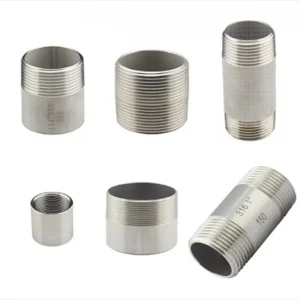Labeling black iron pipe fittings installations is essential for safety, compliance, and maintenance purposes.
Here are the key requirements for labeling black iron pipe fittings installations:
- Identification of Components: Each black iron pipe fitting should be clearly labeled with its size, type, and material specification. This information helps to ensure that the correct fittings are used in the installation and facilitates maintenance and repair activities.
- System Identification: Label the piping system as a whole with relevant information, including the type of fluid or gas conveyed, operating pressure and temperature, and any specific hazards associated with the system. This identification helps to prevent confusion and ensures that personnel are aware of the system’s characteristics and requirements.
- Safety Labels: Place safety labels at strategic locations throughout the installation to alert personnel to potential hazards, such as high-pressure zones, hot surfaces, or confined spaces. Use standardized symbols and warning signs to convey important safety information effectively.
- Directional Arrows: Use directional arrows to indicate the flow direction of fluids or gases within the piping system. These arrows help to ensure that the system is operated correctly and prevent accidental reversal of flow, which could lead to damage or malfunction.
- Emergency Shut-off Locations: Clearly mark the locations of emergency shut-off valves or switches along the piping system. Ensure that these labels are highly visible and easily accessible in case of an emergency to facilitate rapid response and shutdown procedures.
- Material Compatibility: Label piping components and fittings with information regarding material compatibility, particularly if the system conveys corrosive or hazardous substances. This information helps to prevent incompatible materials from coming into contact and causing chemical reactions or degradation.
- Pressure Rating: Display the pressure rating of black iron pipe fittings prominently to ensure that they are used within their specified pressure limits. This information helps to prevent overpressurization of the system, which could lead to leaks, ruptures, or other failures.
- Maintenance Schedule: Include information on maintenance schedules and inspection intervals for the piping system. This helps to ensure that routine maintenance tasks are performed on schedule and that potential issues are identified and addressed in a timely manner.
- Compliance with Standards: Ensure that all labeling conforms to relevant industry standards and regulatory requirements, such as those set by organizations like the American National Standards Institute (ANSI) or the Occupational Safety and Health Administration (OSHA). Compliance with these standards helps to ensure the safety and reliability of the piping system.
- Documentation: Maintain detailed documentation of all labeling applied to the black iron pipe fittings installation, including records of the information provided on labels, locations of labels, and dates of installation or updates. This documentation serves as a reference for maintenance, inspections, and regulatory compliance purposes.
By adhering to these requirements and best practices for labeling black iron pipe fittings installations, you can ensure the safety, reliability, and compliance of the piping system.
